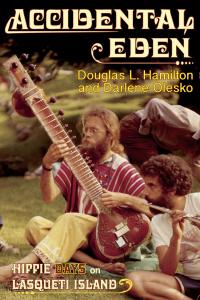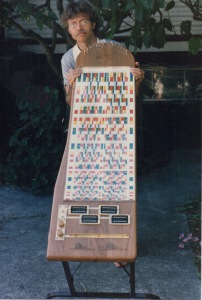AN AUTOBIOGRAPHY OF MUSICAL WRITINGS
I was born in Utrecht, the Netherlands,on January 2, 1948. As a baby my parents immigrated to Canada and I grew up in Ontario. After attending university in the middle to late 1960’s, I moved to the Vancouver region, pursuing alternative lifestyles. For a number of reasons I moved back to the Netherlands in 1993. Now I live in Amsterdam, an inspirational place for someone like me who loves books and music.
As a child in a large family (six kids, I’m the second oldest) my parents kept musical instruments laying around, but they didn’t force us to play them. They just assumed that we would–and we did. My mother always encouraged musical activity. For as long as I can remember I always harboured an interest in musical tuning, but I only became conscious of it during my university years. At that point my focus sat squarely upon 12-et and the organisational issue of sets and permutations. By the mid ’70’s this study came to fruition. Read the introductory essay to my DICTIONARY OF HARMONIC FUNCTIONS FOR 12-ET. It sits under the heading 12-et.
 As a guitarist I knew nothing more than 12-et. But the situation shifted radically when I took up the North Indian sitar in 1970. I soon fell into that intricate world of drone-based just intonation tuning with its ratio complexity. Through the whole ’70’s I maintained an obsession for drone-based music, just intonation and its close equal-tempered surrogate, 53-et. For me, the sitar amounted to pandora’s box. New trajectories flooded out.
As a guitarist I knew nothing more than 12-et. But the situation shifted radically when I took up the North Indian sitar in 1970. I soon fell into that intricate world of drone-based just intonation tuning with its ratio complexity. Through the whole ’70’s I maintained an obsession for drone-based music, just intonation and its close equal-tempered surrogate, 53-et. For me, the sitar amounted to pandora’s box. New trajectories flooded out.
One trajectory focussed on multiple divisions. Since 53-et makes such a good mimic of 5-Limit just intonation, might there not be other systems even better? I discovered a method whereby I can map the tempering characteristics of specific systems. Over time my investigations became less fixated on just intonation and more open to wider morphological issues. By the mid ’80’s I had a sizeable collection of tempered matrices. See my large paper THE MATRIX MODEL under the heading MULTIPLE DIVISIONS.
 Another 1970’s trajectory that came out of the sitar (with its moveable frets) is the monochord and its peculiar form of archaic arithmetic. I went far down this road—as far as what is for me the subliminal. By the early ’80’s I was a monochord ‘expert’ and began to write articles about issues that come out of monochord work. See my monochord-related papers under the heading MONOCHORD.
Another 1970’s trajectory that came out of the sitar (with its moveable frets) is the monochord and its peculiar form of archaic arithmetic. I went far down this road—as far as what is for me the subliminal. By the early ’80’s I was a monochord ‘expert’ and began to write articles about issues that come out of monochord work. See my monochord-related papers under the heading MONOCHORD.
Around the end of the ’70’s I encountered the books by Helmholtz, Partch, and Barbour. I learned much from them, but also realised that I had already worked out the essential arithmetic myself. In the early ’80’s I acquired the two books by Ernest McClain. They influenced me a lot, even though I disagreed with some of his speculations. These books confirmed that I was correct to take monochords seriously as a springboard for philosophical questions. Also around this time I connected with a whole community of like-minded tuning researchers,mostly on the west coast of America. This networking happened through the remarkable efforts of Mark Rankin, to whom I owe very much. During the ’70’s I had lived mostly in rural Canada. I had no idea that anyone else was interested in alternative musical tunings. I worked it out myself.
The ’80’s formed an incredibly creative and productive time for me. In 1981 I refretted a guitar into 31-et and became interested in the topic of an ergonomic color-code for microtonally fretted instruments. During the ’80’s I developed a rainbow sequence based on the circle of fifths. Then I found it too ‘busy’ and eventually refined a system that needs only black, white, and two shades of grey in the early ’90’s. This one is optimal. Also in the mid ’80’s I built two long-stringed polychords (applied monochords), steel guitars that use interchangeable fret-boards as ‘fret-guides. In addition, (perhaps my proudest achievement) I developed a color-code using only black and white, intended for fretless instruments that make a comma-resolution of harmony (53-et and just intonation) easily accessible. See pictures of my various musical instruments under the heading MUSICAL INSTRUMENTS.
Also in the ’80’s, I took an interest in developing an ergonomic music keyboard that makes playing in alternative systems easier than the standard (relatively limited) keyboard. I built models and tried them out for ‘feel.’ By the late ’80’s I had a design that seemed satisfactory to me—actually two complimentary designs that I tentatively called ‘the male and the female.’ Through the auspices of Johnny Reinhard the male was built in New York in the early ’90’s. It has subsequently been dubbed ‘the Terpstra Keyboard.’ See keyboard related material under the heading KEYBOARDS.
During the ’80’s I took an active interest in well-temperament or irregular temperaments. By 1990 this research culminated in my large paper THE DIVISION OF THE DITONIC COMMA. Some people consider it my best piece, but of course that is debatable. Explore the world of circulating temperaments, both its historical and structural aspects, under the heading WELL-TEMPERAMENTS.
During the ’80’s my obsession with just intonation waned as my appreciation for 31-et (extended meantone) grew apace. By the late ’80’s I preferred temperaments over just intonation. My fascination with meantone involved both historical aspects and theoretical issues. From the mid’80’s I began to write papers on the subject. See this collection of writings under the heading MEANTONE.
Already during the ’70’s I became interested in the vexed question of musical notation for just intonation. In the mid ’80’s I wrote a paper (published by the University of Utrecht) defending my system of notation for 53-et and just intonation. But I also realised that every multiple division needs its own variant notation that reflects its structural peculiarities. I developed an integrated system based on the boundary points of the matrix, a system that can be appropriately modified for any particular multiple division. This information can be found with the associated matrix under the heading of MULTIPLE DIVISIONS. As to notation for n-limit just intonation, I eventually gave up in frustration. Complexity is undeniable.
Also, during the ’80’s my monochord work took an unexpected turn. While formulating the underlying principles, terminology, and problematics of the monochord field I discovered that I had essentially reproduced the language and issues of early Greek philosophy—roots and compounds, limits in various contexts, reciprocals, digital versus analog conceptions of harmony, the status of irrationals, the continuum, infinite divisibility, genus, etc. I began a reexamination of what early Greek philosophy is all about. By the mid ’90’s my research had gelled into an alternative perspective on the beginnings of philosophy. So I began to write papers on each philosopher in turn—Anaximander, Xenophanes, Heraclitus, Parmenides, etc. The book is called SEPARATING EARTH AND SKY: A MUSICAL HISTORY OF EARLY GREEK PHILOSOPHY. Recently I have written a concise summary of the main arguments of my philosophy project. It is called RESTORING THE MUSE. See all of my philosophy work under the heading PHILOSOPHY.
The philosophy work brings me full circle because my old university degrees was in philosophy. As regards musical tuning I am entirely self-taught. However, have come to inhabit a niche that sits where philosophy and music overlap. My philosophy project is not yet finished.
In 2003 I acquired an oud (arabic lute) while visiting Cairo. It’s like a fretless guitar that allows wonderfully free intonation on the fly. It quickly became my favourite instrument, though I still play microtonal guitars and other things. I also modify instruments for other people. In the last decade I have been playing more, which leaves less time for writing. But I still have more to do.
At certain points in my explorations I have written papers that prove to be difficult to classify under the headings given so far. I decided to make a grab-bag heading called MISCELLANEOUS.
Enjoy.